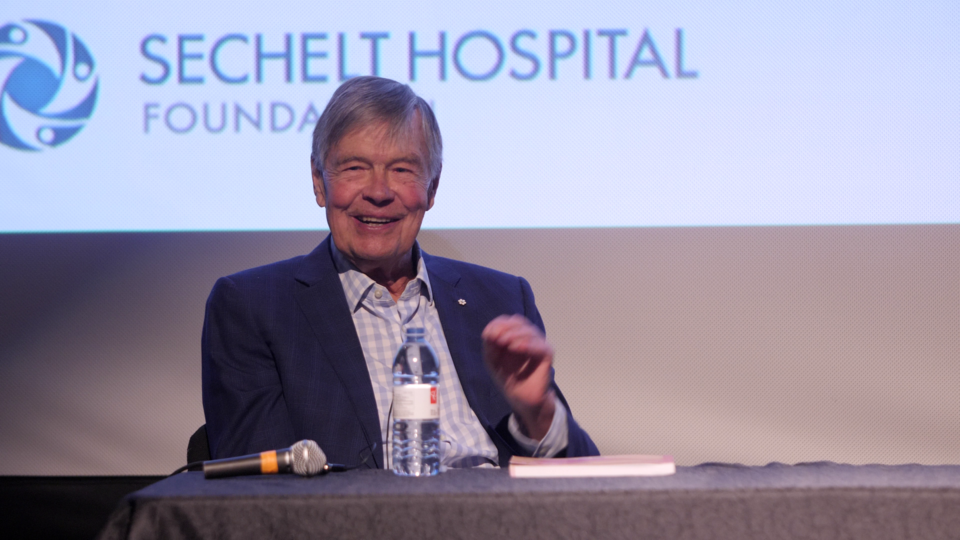Anglophone Canadians aged 30 and younger are markedly less happy than any other age group in the country, says the World Happiness Report, created by using data from the Gallup World Poll, which is then analyzed by a global team led by the University of Oxford.
The report, released in March on World Happiness Day, also found Canada overall ranked 15 out of 156 countries, dropping two places since 2023. The U.S. dropped from 15th place to 22, making it the first year the country has been knocked out of the top 20 since the launch of the report, 12 years ago. Meanwhile, Finland maintained first place as the happiest country in the world for the seventh year in a row.
Dr. John Helliwell, founding editor of the report and one of the world's foremost happiness experts, was in Sechelt last week, Oct. 9, to speak at two events organized by the Sechelt Hospital Foundation. The first was a public presentation held at Raven’s Cry Theatre and was followed by an intimate dinner with Friends of the Foundation and Sunshine Coast Botanical Garden. Following the events, Helliwell spoke with Coast Reporter from his office at UBC where he is professor emeritus of economics, to clarify how the report measures happiness worldwide — and why it matters.
“The key question we focus on is one that asks people to evaluate their life as a whole. 'How is your life today on a scale of zero to 10?'” says Helliwell. “And they all seem to attach similar meaning to that question.”
He adds, participants weren’t explicitly questioned about happiness but rather asked to evaluate the quality of their lives. He notes, that’s different than asking emotional questions, such as, “how happy were you yesterday?” Or, “how sad were you yesterday?” Instead, happiness is measured by three key components, life evaluations, positive emotions and negative emotions.
“How happy are you at this very moment or how sad you are, those emotions are very important supports or detractors from this broader life evaluation, but the broader life evaluation is what we do to measure the quality of life all over the world,” says Helliwell, who adds the report originated from his interest in social connections and “social capital,” about 30 years ago.
Helliwell says at the time, he learned from colleague, American political scientist Robert Putnam, that there were measures available for quality of life and people gave higher values to answers where social connections were good.
“And so, I said, ‘Well, that's what we need,’” says Helliwell. “We've been doing without this in economics for two centuries. We started out saying happiness was what it was all about. And then, because material measures of progress were all that has been regularly comparably measured across countries, and over time, there was increasing emphasis on thinking about gross national product as though it was the objective.”
He adds, it was the King of Bhutan in the 1970s who said, “Gross National Happiness is more important than Gross Domestic Product.” Helliwell says that started a movement in Bhutan and he was soon invited to attend “gross national happiness conferences.” A resolution was then put before the United Nations General Assembly in 2011, which recommended make happiness and well-being part of the nations’ national policies. It was in 2012 when the first World Happiness Report was published.
Halliwell says it was during the COVID-19 pandemic when some of the report’s findings around life evaluations were truly highlighted.
“And everybody said, ‘How could this be? Our lives are torn asunder. We can't go out, we can't meet our friends, we can't go to school, we can't go to work, and so many of us are dying?’” says Halliwell. “It turns out that wasn't true and part of the reason they were not less happy is that there was a big surge, that we documented in 2020 and every year since, in benevolence, the extent to which we donated to help others and, most strikingly, an increase in the extent to which they help strangers.”
He said not only did helping others makes people happier, it reminded them that the communities they live in are much more benevolent and much more caring about each other than previously thought.
“And since how happy you are depends on how helpful you think other people are, then they became happier, or at least they didn't become less happy,” says Helliwell.
He notes the least happy demographic in Canada, anglophones under 30, are significantly less happy than they were 10 years ago. He says, surprisingly, it’s not social media stressing them out, but rather polarization and media/news sources, which are constantly delivering more bad news than good. He says one example is young people living in countries with post-colonial histories, including residential schools in Canada, who are feeling pressure to take on the responsibility to try and fix past wrongs.
“They're not even doing anything wrong now, but they're thinking about the past,” says Helliwell. “And the answer is, I think, is that they haven't yet acted in response to those worries in the same way that they were naturally able to act in a pro-social way when COVID came along, or when an earthquake comes along or a flood, when people rush out to help each other. In this context, people are more, I mean this thus far and among the younger groups, they're sort of discouraged about the future.”
Combine that with other serious issues, including gender identification and rising house prices, and it’s no wonder young people are worried, says Helliwell.
You can read the World Happiness Report in its entirety at worldhappiness.report.
Words missing in article? Your adblocker might be preventing hyperlinked text from appearing.



